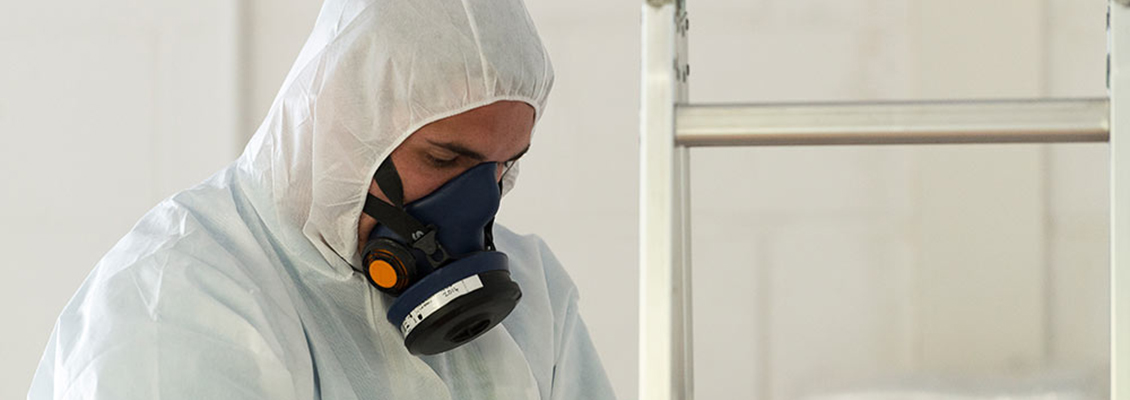Finding asbestos in a church can often fill you with dread. Ian Simpson, Places of Worship Support Officer for the Diocese of Birmingham, has provided this comprehensive guidance on what to do if you have asbestos within your building.
Once considered a “wonder material” for its fire-resistant properties, asbestos was widely used in buildings from about 1850 until the 1970s when it became clear that long-term exposure to its microscopic fibres in the air caused serious and incurable lung disease in many individuals. Its use in construction in the UK was finally outlawed in 1999.
Many buildings, including churches, built or modified before 1999 contain asbestos in one form or another. It is commonly found in old pipe lagging, in floor and ceiling tiles, in textured finishes (the “A” of “Artex™” is asbestos) and in some elderly plastics and electrical components. While it remains in good condition and undisturbed, it is nothing at all to worry about. Once damaged or left to deteriorate, however, asbestos-containing materials can release fibres into the atmosphere – this is when they pose a potential health risk.
The Control of Asbestos Regulations 2012 apply to all public buildings, churches included, and are intended to protect everyone who uses these buildings from the harmful effects of asbestos. In addition to complying with the law, as Christians we have a calling to love our neighbours and protect them from coming to harm; part of the outworking of that calling is to ensure that the buildings in which we worship God and offer hospitality to His people are free from dangerous substances.
It is far simpler than you might think to ensure your church complies with the law on asbestos in non-domestic buildings. The first thing you must do is find out whether your building contains asbestos. If it does, you need to make a record of where it is, how much of it there is and what condition it is in. The best way of doing this is to have the building professionally surveyed by a trained and, importantly, UKAS-accredited asbestos surveyor. The cost of this survey will depend upon the size and complexity of your building.
If during the survey material is discovered which may contain asbestos, small samples will be taken away for laboratory examination which will prove conclusively whether it does or not. If there is a suspected asbestos-containing material which cannot be sampled then the law requires that it be treated as though it does contain asbestos.
The survey report will include an Asbestos Register listing the location, quantity and condition of any asbestos-containing material found. It will also contain an assessment (based upon the type, condition and accessibility of the material) of the risk of these materials releasing fibres into the air, together with recommendations for how the materials should be managed going forward.
Once you have the completed survey it is your legal responsibility to put into action the plan for managing the asbestos. Depending upon what your surveyor recommends, this could be as simple as affixing warning stickers or restricting access to affected areas. You will need to monitor and review these actions over time; to assist you in this, your surveyor will propose a re-inspection interval to assess any changes in the condition of the asbestos.
It is also your responsibility to make any tradespeople working in the building aware of the location and type of any asbestos in the building so they can protect themselves from it. It is good practice to point out the locations of any asbestos (or suspected asbestos) before they start work and have them sign a copy of the Asbestos Register. Reputable tradespeople will know the Golden Rule: if they discover asbestos (or suspect its presence) during a job, they must stop work immediately, vacate the area and report it.
If asbestos needs to be removed from your church, this can be a big job and needs to be done by a licensed contractor. It will also need a Faculty, so it is important to contact your DAC as soon as possible. Asbestos-related work is never “cheap”, but quotations can differ widely so try to get at least three to ensure the best value.
If you are wondering where to find a suitably-qualified and UKAS-accredited asbestos surveyor, help is at hand. MaintenanceBooker from the National Churches Trust is a free resource dedicated to putting churches in touch with pre-vetted contractors, including specialists in all aspects of asbestos management, who will be happy to quote for the work. Churches of all denominations, Listed and unlisted, are invited to join without obligation at http://www.maintenancebooker.com.
A free booklet giving more information on asbestos in churches is available on the Diocese of Liverpool’s website: http://liverpool.anglican.org/index.php?p=545 (“Useful Downloads” box).
A.M.D.G.
Ian Simpson, Birmingham, 12th July 2019.

